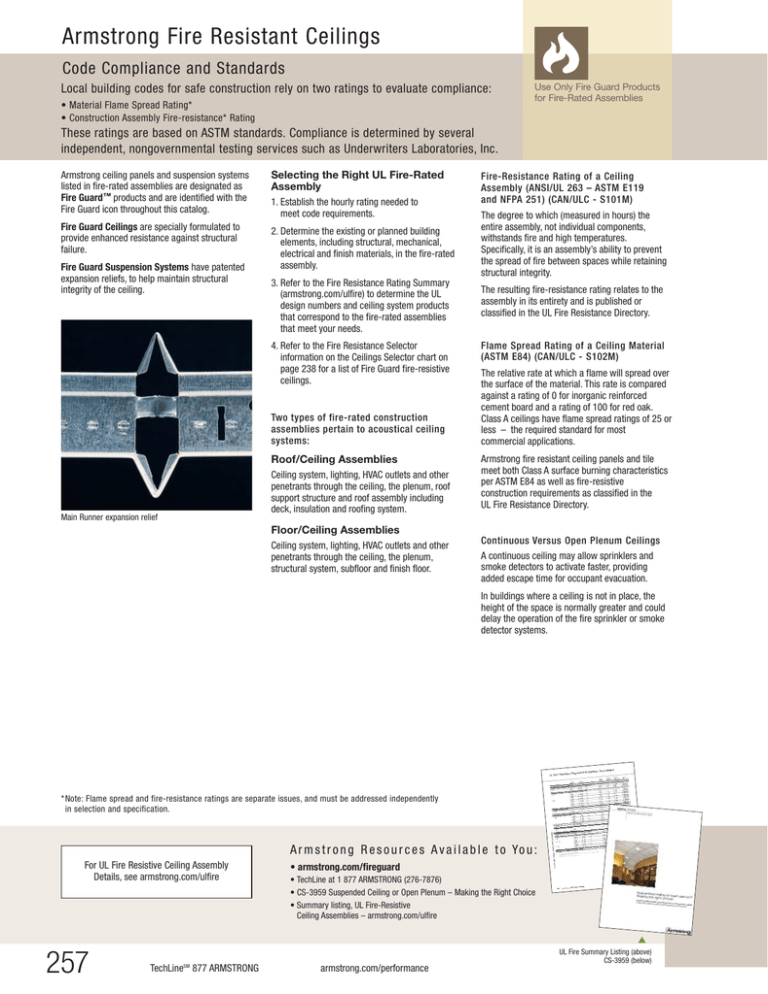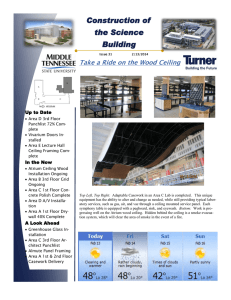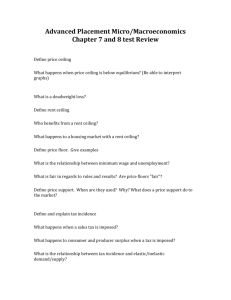information about fire performance.
advertisement

Armstrong Fire Resistant Ceilings Code Compliance and Standards Local building codes for safe construction rely on two ratings to evaluate compliance: • Material Flame Spread Rating* • Construction Assembly Fire-resistance* Rating Use Only Fire Guard Products for Fire-Rated Assemblies These ratings are based on ASTM standards. Compliance is determined by several independent, nongovernmental testing services such as Underwriters Laboratories, Inc. Armstrong ceiling panels and suspension systems listed in fire-rated assemblies are designated as Fire Guard ™ products and are identified with the Fire Guard icon throughout this catalog. Selecting the Right UL Fire-Rated Assembly Fire Guard Ceilings are specially formulated to provide enhanced resistance against structural failure. 2. Determine the existing or planned building elements, including structural, mechanical, electrical and finish materials, in the fire-rated assembly. The degree to which (measured in hours) the entire assembly, not individual components, withstands fire and high temperatures. Specifically, it is an assembly’s ability to prevent the spread of fire between spaces while retaining structural integrity. 3. Refer to the Fire Resistance Rating Summary (armstrong.com/ulfire) to determine the UL design numbers and ceiling system products that correspond to the fire-rated assemblies that meet your needs. The resulting fire-resistance rating relates to the assembly in its entirety and is published or classified in the UL Fire Resistance Directory. Fire Guard Suspension Systems have patented expansion reliefs, to help maintain structural integrity of the ceiling. 1. Establish the hourly rating needed to meet code requirements. 4. Refer to the Fire Resistance Selector information on the Ceilings Selector chart on page 238 for a list of Fire Guard fire-resistive ceilings. Two types of fire-rated construction assemblies pertain to acoustical ceiling systems: Roof/Ceiling Assemblies Main Runner expansion relief Ceiling system, lighting, HVAC outlets and other penetrants through the ceiling, the plenum, roof support structure and roof assembly including deck, insulation and roofing system. Fire-Resistance Rating of a Ceiling Assembly (ANSI/UL 263 – ASTM E119 and NFPA 251) (CAN/ULC - S101M) Flame Spread Rating of a Ceiling Material (ASTM E84) (CAN/ULC - S102M) The relative rate at which a flame will spread over the surface of the material. This rate is compared against a rating of 0 for inorganic reinforced cement board and a rating of 100 for red oak. Class A ceilings have flame spread ratings of 25 or less – the required standard for most commercial applications. Armstrong fire resistant ceiling panels and tile meet both Class A surface burning characteristics per ASTM E84 as well as fire-resistive construction requirements as classified in the UL Fire Resistance Directory. Floor/Ceiling Assemblies Ceiling system, lighting, HVAC outlets and other penetrants through the ceiling, the plenum, structural system, subfloor and finish floor. Continuous Versus Open Plenum Ceilings A continuous ceiling may allow sprinklers and smoke detectors to activate faster, providing added escape time for occupant evacuation. In buildings where a ceiling is not in place, the height of the space is normally greater and could delay the operation of the fire sprinkler or smoke detector systems. * Note: Flame spread and fire-resistance ratings are separate issues, and must be addressed independently in selection and specification. A r m s t r o n g R e s o u r c e s A v a i l a b l e t o Yo u : For UL Fire Resistive Ceiling Assembly Details, see armstrong.com/ulfire • armstrong.com/fireguard • TechLine at 1 877 ARMSTRONG (276-7876) • CS-3959 Suspended Ceiling or Open Plenum – Making the Right Choice • Summary listing, UL Fire-Resistive Ceiling Assemblies – armstrong.com/ulfire ▲ 257 TechLineSM 877 ARMSTRONG armstrong.com/performance UL Fire Summary Listing (above) CS-3959 (below)






